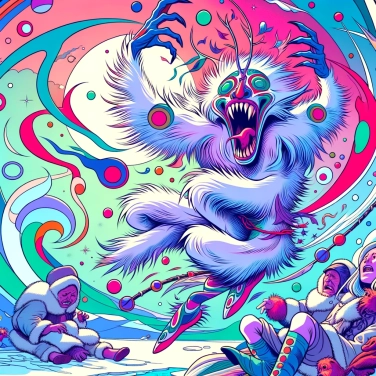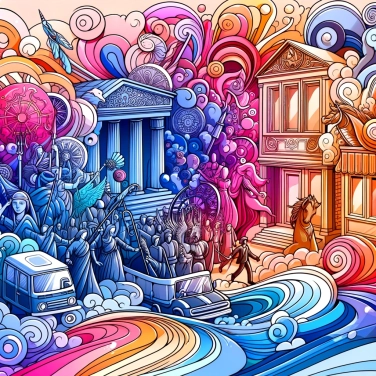The Inuit tell stories about the Trickster to convey moral teachings, explain natural phenomena, and entertain the community.

Among the Inuit, the Trickster, often represented in the form of a cunning animal like the raven, plays a central role in the culture. This mischievous character embodies both wisdom and folly, order and chaos. With his unpredictable behavior, he serves as a reminder to people that life is complex and full of paradoxes. The stories of the Trickster provide the Inuit with a way to reflect on their own actions and behaviors with humor and perspective. Through these tales, the community shares its beliefs and values, thus reinforcing a sense of belonging and cultural continuity from one generation to the next.
The stories of the Trickster among the Inuit serve to convey key values such as humility, respect, wisdom, and responsibility to younger generations. Through the misadventures of the Trickster, who often acts maliciously but usually ends up being the victim of his own trick, the tales illustrate the negative consequences of selfish, reckless, or disrespectful behavior. These stories also teach not to consider oneself superior to others, to think before acting, and help young Inuit understand that every action has clear consequences. The funny, clumsy, or mischievous character of the Trickster makes these teachings more impactful and less moralistic, facilitating their assimilation in the minds of those who listen to the tales.
Among the Inuit, Trickster stories are not just for entertainment or passing the time: they mainly teach young people how to behave properly in society. Indeed, through the funny and often absurd misadventures of the Trickster, the Inuit quickly grasp which limits should not be crossed. Classic themes such as humility, responsibility, and cooperation emerge from these popular tales. When the clever hero makes a mistake or tries to deceive others, he often ends up punished, ridiculed, or in really complicated situations. No need for long speeches; these stories clearly remind children (and even adults) why it is better to follow certain social rules rather than act selfishly or impulsively. Essentially, Trickster stories serve as a practical guide to community life.
Among the Inuit, the Trickster stories are a true cultural treasure. By recounting his adventures, they keep their traditional language, beliefs, and ways of living from their ancestors alive. These tales are somewhat like the cement that allows generations to stay connected to their past. When the elders tell these stories, they also indirectly pass on elements of their own identity: fishing, hunting, survival in icy environments. Without these narratives, a significant part of Inuit identity might risk being lost over time.
The stories of the Inuit Trickster not only serve to entertain, but they are also used to convey practical knowledge such as hunting, survival, and behaviors to adopt in the face of the hostile Arctic environment.
In some Inuit communities, telling a Trickster story is akin to a form of collaborative learning, where listeners and narrators engage in a discussion about the moral lessons to be learned.
The Inuit Trickster is neither completely good nor entirely evil; he often symbolizes the ambiguity of life, reminding us that the line between wisdom and absurdity can sometimes be very thin.
The Trickster tales among the Inuit can vary from one community to another, reflecting regional specificities and enriching the cultural diversity of the Inuit.
These ambiguous characters teach critical thinking by allowing for the analysis of their choices and actions. The nuances provided by these narratives also help to understand the moral complexity of the real world.
The stories of the Trickster often teach Inuit children the importance of collaboration, respect for the environment and social group, as well as the consequences of reckless or selfish behaviors.
Even today, telling these stories helps to preserve and transmit Inuit cultural values, maintain their ethnic identity, and strengthen the bonds between generations.
Yes, the figure of the Trickster is found in many other cultures around the world, such as the coyote among several Indigenous peoples in North America, or Anansi the spider in West Africa, with each culture bringing its own meanings and contexts to the stories.
In Inuit culture, the Trickster is often represented by a figure such as the raven or sometimes a fox. This character is cunning, unpredictable, and plays tricks on other beings, both humans and animals, thereby illustrating important moral lessons.

No one has answered this quiz yet, be the first!' :-)
Question 1/5